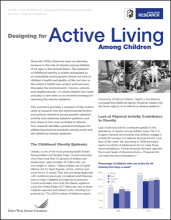We are pleased to announce an exciting new alliance between Active Living Research and GP RED to co-host and coordinate...
Designing for Active Living Among Children

The Challenge: Obesity is one of the most pressing health concerns for children. Nearly one-third of children and teens, more than 23 million kids, are overweight or obese. Regular physical activity supports overall health and helps children maintain a healthy weight. However, the design of our cities, neighborhoods and transportation systems can make it difficult for children to be physically active. The absence of parks, trails and other recreational facilities also is a barrier to regular physical activity. This is especially true among children in low-income neighborhoods and communities of color. In addition, schools do not provide enough time for children to be active.
Make an Impact: Neighborhoods, parks and recreational resources, and schools can help children be more active. Providing safe places for kids to play, increasing their opportunities for regular physical activity and supporting families’ efforts to integrate physical activity into their daily routine are important strategies for reversing the childhood obesity epidemic.
What the findings are about: This summary reviews research on the environmental factors and policies related to youth’s physical activity and sedentary behavior patterns, and how these in turn may be linked to obesity. It highlights potential strategies for increasing physical activity among youth.
- Children and teens living in low-income communities and African-American, Latino, Native American, Asian and Pacific Islander children have a low percentage of physically active youth and are especially vulnerable to obesity.
- Children and adolescents living in communities with parks, playgrounds, trails and recreation programs tend to be more physically active than those living in neighborhoods with fewer recreational facilities.
- Sidewalks and destinations within walking distance were linked with greater physical activity among children, while traffic hazards and unsafe intersections were linked with lower levels of physical activity.
- Implementing Safe Routes to School programs increases the number of students who walk to school
- Decreasing children’s TV time may help children lose weight, primarily because watching TV displaces time for physical activity and exposes children to advertisements for high-calorie, low-nutrition foods.
- School-based interventions aimed at increasing physical activity effectively reduced TV viewing hours and reduced the prevalence of obesity.
- DOWNLOAD "Designing for Active Living Among Children" PDF (0.41 MB) Research Briefs & Syntheses
Related Tools & Resources
STAY UP TO DATE
RECENTLY ADDED TOOLS & RESOURCES
MOVE! A BLOG ABOUT ACTIVE LIVING
The "Active Living Conference" aims to break down research and practice silos and...







